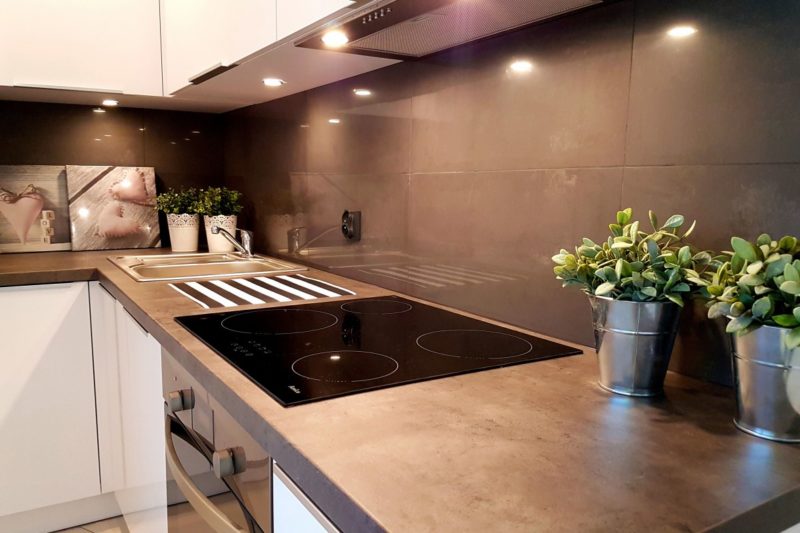Are you wondering why can’t you use cast iron on a glass top? While the glistening and gorgeous glass and ceramic fireplace tops need more care than coil tops. Dragging canned goods and cast iron skillets might scratch the surface of the stove. In addition, the heating may damage the component of the stove top in the worst-case situation. Even if some people think cast iron on a glass top stove is OK, it’s a hazardous offering. In this post, you will know the factors that make it not ideal to use cast iron on a glass stove. So, why can’t you use cast iron on a glass top?

Factors Why Can’t You Use Cast Iron On Glass Top
Even the words glass top stove and cast iron are absurd and rim on the edge of being hazardous. These two common kitchen appliances are typically considered incompatible! It seems relatively straightforward. A cast-iron skillet can be hefty; however, the glass cooktop (made of glass) looks pretty fragile. Iron is typically seen as a primitive cooking utensil rather than the modern one from the past. Glass stoves are located on the other end of the range; they appear as contemporary as any other cooking appliance installed!
#1. Weight
Cast iron alone is a hefty metal. Put a great deal of weight on the glass cooktop and add soup or water to the pot. Even if the top resists the weight, it may be broken by raising the cast iron pot. So, when using cast iron on a glass cooktop, remember weight and composition.
#2. Apartment bottoms
For uniform heat distribution on ceramic and glass burner stoves, pots with flat surfaces are needed. Unfortunately, most iron cast cookware is not flat. It means that it will longer to heat. This slower technique of heating might prolong the cooking time and lead to uneven heating.
#3. Size
The optimal pot size is only 1 inch wider than the burner. Many cast-iron cups on your glass top stove are significantly more significant than the burners. If the heat is more than it needs to be, it is not uniformly dispersed over the pot’s surface. The element cycles on and off to reduce cooking speed and reduce the lifespan of the element.
Meaning to say, the heat is contained in a big, heavy container, such as cast iron traps, under the cookware. The life of the element is decreased by heat buildup, resulting in damage to the cooktop surface.
#4. Finish
Cast iron has a raw finish, which can damage a glass cooktop’s surface. Porcelain enamel cast iron is an alternative on a glass top. Ensure the finish is smooth and the cast iron is thoroughly coated to avoid scratches. If you use the enameled pot on a high heat setting for a long time, the pot retains the heat. In case the temperature restrictions indicate that the top is too hot, the element can be disabled. The metal of choice for ceramic or glass cooktops is stainless steel. Although gray markings may persist on the surface, aluminum can be used.
How Do You Keep A Top Cast Iron Stove In Excellent Shape?
Use a contemporary glass cooktop to replace an outdated electric burner or gas stove. But you’re not prepared to give up your love of cast iron cookware, and there’s no reason. You don’t have to pick between your beautiful glass cooktop and the solid cast iron. The burners are isolated from regular electric or gas cooktop surfaces; it’s pretty simple to utilize iron cookware. It’s a whole different story with a glass top. When you cook, iron must sit on the surface of the glass, and things may get a bit risky. To, understand more read on
You won’t have any difficulties with the correct care and attention with your heavy iron cooking equipment. These are actually some of our favorite ideas and methods to easily combine iron-glass cooking. Don’t let your iron slide!
The usage of older iron skillets or pots is especially essential since they have more uneven surfaces, so we advocate updating! Appropriate tools make your beloved cast-iron skillet much easier to use. Place it firmly on the glass cooktop in a smooth stroke while using cast iron cooking equipment. You risk scratching the glass if you try to move it around once you have begun cooking. It can appear easy, but the easiest method to prevent damage is to avoid sliding iron on the top of the glass stove. To help you, read on how to protect glass top stove from cast iron cookware.
It’s A Wrap!
After you have figured out why can’t you use cast iron on a glass top, you might try investing in a heat diffuser for use in your glass tops when cooking with cast iron. Heat diffusers are meant to disseminate heat from a brand onto the bottom of a pot uniformly.
These are ideal for individuals who create sauces or want to cook slowly. When cooking on delicate glass stovetops, it is also desirable that a heat diffuser serves as a buffer between your pot or cup and the glass. To avoid scratches, place the heat diffuser firmly on the glass. For more articles about stove, you can read on why is the frame on my gas stove orange and how to use a gas stove. Thanks for stopping by! Until next time.
